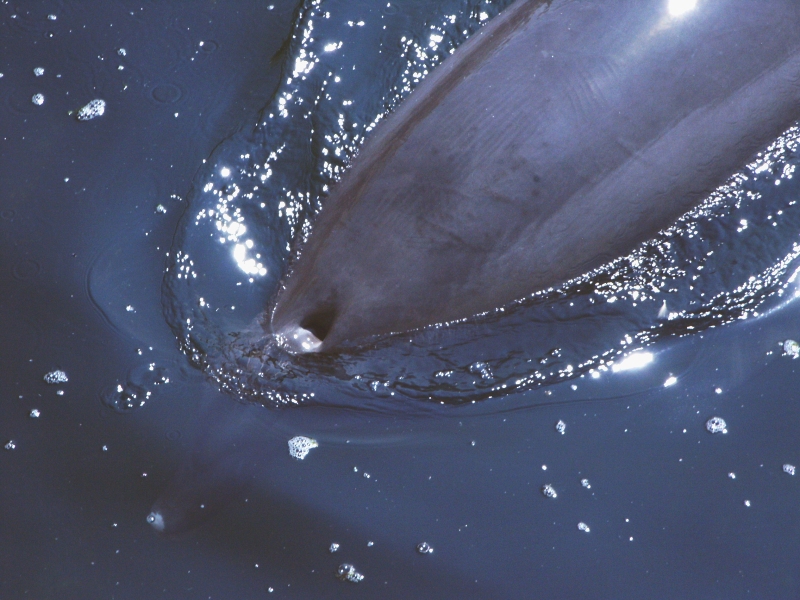Blowhole (anatomy) on:
[Wikipedia]
[Google]
[Amazon]

 In
In
Whales don't spray water out of their blowholes
Gizmodo
Whales of the World
Cetacean anatomy {{Vertebrate anatomy-stub

 In
In cetology
Cetology (from Greek , ''kētos'', "whale"; and , ''-logia'') or whalelore (also known as whaleology) is the branch of marine mammal science that studies the approximately eighty species of whales, dolphins, and porpoises in the scientific order ...
, the study of whales and other cetaceans
Cetacea (; , ) is an infraorder of aquatic mammals that includes whales, dolphins, and porpoises. Key characteristics are their fully aquatic lifestyle, streamlined body shape, often large size and exclusively carnivorous diet. They propel t ...
, a blowhole is the hole (or spiracle) at the top of the head through which the animal breathes air. In baleen whale
Baleen whales ( systematic name Mysticeti), also known as whalebone whales, are a parvorder of carnivorous marine mammals of the infraorder Cetacea ( whales, dolphins and porpoises) which use keratinaceous baleen plates (or "whalebone") in th ...
s, these are in pairs. It is homologous
Homology may refer to:
Sciences
Biology
*Homology (biology), any characteristic of biological organisms that is derived from a common ancestor
*Sequence homology, biological homology between DNA, RNA, or protein sequences
* Homologous chrom ...
with the nostril
A nostril (or naris , plural ''nares'' ) is either of the two orifices of the nose. They enable the entry and exit of air and other gasses through the nasal cavities. In birds and mammals, they contain branched bones or cartilages called t ...
of other mammals, and evolved via gradual movement of the nostrils to the top of the head. The posterior placement of blowholes on cetacean heads is believed to minimize the energy used when breathing at the water's surface. As whales reach the water surface to breathe, they forcefully expel air through the blowhole. The exhalation is released into the comparably lower-pressure, colder atmosphere, and any water vapor
(99.9839 °C)
, -
, Boiling point
,
, -
, specific gas constant
, 461.5 J/( kg·K)
, -
, Heat of vaporization
, 2.27 MJ/kg
, -
, Heat capacity
, 1.864 kJ/(kg·K)
Water vapor, water vapour or aqueous vapor is the gaseous p ...
condenses. This spray, known as the ''blow'', is often visible from far away as a white splash, which can also be caused by water resting on top of the blowhole.
Purpose and mechanism
Air sacs just below the blowhole allow whales to produce sounds for communication and, fortoothed whale
The toothed whales (also called odontocetes, systematic name Odontoceti) are a parvorder of cetaceans that includes dolphins, porpoises, and all other whales possessing teeth, such as the beaked whales and sperm whales. Seventy-three species ...
s, echolocation. These air sacs are filled with air, which is then released again to produce sound in a similar fashion to releasing air from a balloon. When whales dive under water their nasal plug covers the nasal passage to the blowhole. The muscles controlling the nasal plug are relaxed during this time, but when the whale comes up for air these muscles contract and allow for the blowhole to be opened and the process of exhalation and inhalation to occur.
Baleen whale
Baleen whales ( systematic name Mysticeti), also known as whalebone whales, are a parvorder of carnivorous marine mammals of the infraorder Cetacea ( whales, dolphins and porpoises) which use keratinaceous baleen plates (or "whalebone") in th ...
s have two blowholes positioned in a V-shape while toothed whale
The toothed whales (also called odontocetes, systematic name Odontoceti) are a parvorder of cetaceans that includes dolphins, porpoises, and all other whales possessing teeth, such as the beaked whales and sperm whales. Seventy-three species ...
s have only one blowhole. The blowhole of a sperm whale
The sperm whale or cachalot (''Physeter macrocephalus'') is the largest of the toothed whales and the largest toothed predator. It is the only living member of the genus '' Physeter'' and one of three extant species in the sperm whale famil ...
, a toothed whale, is located left of centre in the frontal area of the snout, and is actually its left nostril, while the right nostril lacks an opening to the surface and its nasal passage is otherwise well developed.
References
External links
Whales don't spray water out of their blowholes
Gizmodo
Whales of the World
Cetacean anatomy {{Vertebrate anatomy-stub